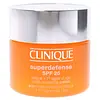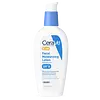What's inside
What's inside
 Key Ingredients
Key Ingredients

 Benefits
Benefits

 Concerns
Concerns

 Ingredients Side-by-side
Ingredients Side-by-side

Water
Skin ConditioningEthylhexyl Salicylate
UV AbsorberHomosalate
Skin ConditioningButyloctyl Salicylate
Skin ConditioningDimethicone
EmollientPolyester-8
Skin ConditioningButyl Methoxydibenzoylmethane
UV AbsorberCetearyl Alcohol
EmollientGlyceryl Stearate
EmollientPEG-100 Stearate
Shea Butter Ethyl Esters
EmollientButylene Glycol
HumectantPetrolatum
EmollientStyrene/Acrylates Copolymer
Glycerin
HumectantNiacinamide
SmoothingTrehalose
HumectantVp/Eicosene Copolymer
Daucus Carota Sativa Root Extract
Skin ConditioningBrassica Oleracea Gemmifera Extract
AstringentVaccinium Macrocarpon Fruit Extract
AstringentResveratrol
AntioxidantBrassica Oleracea Italica Extract
AstringentAcetyl Carnitine Hcl
Skin ConditioningVaccinium Angustifolium Fruit Extract
Skin ProtectingSalicylic Acid
MaskingBrassica Oleracea Acephala Leaf Extract
HumectantCreatine
Skin ConditioningSpinacia Oleracea Leaf Extract
Skin ConditioningCucumis Sativus Fruit Extract
EmollientLactobacillus Ferment
Skin ConditioningAdenosine Phosphate
Skin ConditioningHordeum Vulgare Extract
EmollientSigesbeckia Orientalis Extract
Skin ConditioningAlbizia Julibrissin Bark Extract
MaskingArabidopsis Thaliana Extract
AntioxidantPlankton Extract
Skin ConditioningIsohexadecane
EmollientOryza Sativa Bran Extract
Skin ConditioningPotassium Cetyl Phosphate
EmulsifyingTocopheryl Acetate
AntioxidantCaffeine
Skin ConditioningEthylhexylglycerin
Skin ConditioningAlgae Extract
EmollientMicrococcus Lysate
Skin ConditioningErgothioneine
AntioxidantSodium Hyaluronate
Humectant7-Dehydrocholesterol
Emulsion StabilisingCaprylyl Glycol
EmollientBiosaccharide Gum-4
Skin ConditioningHydrogenated Palm Glycerides
EmollientAcrylates/C10-30 Alkyl Acrylate Crosspolymer
Emulsion StabilisingPropylene Glycol Dicaprate
EmollientPEG-8 Laurate
EmulsifyingHelianthus Annuus Seedcake
AbrasivePolyethylene
AbrasiveYeast Extract
Skin ConditioningTromethamine
BufferingDimethiconol
EmollientSodium Rna
Skin ConditioningPolysorbate 80
EmulsifyingLecithin
EmollientSea Whip Extract
Skin ConditioningXanthan Gum
EmulsifyingAcrylamide/Sodium Acryloyldimethyltaurate Copolymer
Emulsion StabilisingTetrahexyldecyl Ascorbate
AntioxidantPropylene Glycol Caprylate
Skin ConditioningPhytic Acid
Disodium EDTA
BHT
AntioxidantPhenoxyethanol
PreservativeMica
Cosmetic ColorantCI 77891
Cosmetic ColorantWater, Ethylhexyl Salicylate, Homosalate, Butyloctyl Salicylate, Dimethicone, Polyester-8, Butyl Methoxydibenzoylmethane, Cetearyl Alcohol, Glyceryl Stearate, PEG-100 Stearate, Shea Butter Ethyl Esters, Butylene Glycol, Petrolatum, Styrene/Acrylates Copolymer, Glycerin, Niacinamide, Trehalose, Vp/Eicosene Copolymer, Daucus Carota Sativa Root Extract, Brassica Oleracea Gemmifera Extract, Vaccinium Macrocarpon Fruit Extract, Resveratrol, Brassica Oleracea Italica Extract, Acetyl Carnitine Hcl, Vaccinium Angustifolium Fruit Extract, Salicylic Acid, Brassica Oleracea Acephala Leaf Extract, Creatine, Spinacia Oleracea Leaf Extract, Cucumis Sativus Fruit Extract, Lactobacillus Ferment, Adenosine Phosphate, Hordeum Vulgare Extract, Sigesbeckia Orientalis Extract, Albizia Julibrissin Bark Extract, Arabidopsis Thaliana Extract, Plankton Extract, Isohexadecane, Oryza Sativa Bran Extract, Potassium Cetyl Phosphate, Tocopheryl Acetate, Caffeine, Ethylhexylglycerin, Algae Extract, Micrococcus Lysate, Ergothioneine, Sodium Hyaluronate, 7-Dehydrocholesterol, Caprylyl Glycol, Biosaccharide Gum-4, Hydrogenated Palm Glycerides, Acrylates/C10-30 Alkyl Acrylate Crosspolymer, Propylene Glycol Dicaprate, PEG-8 Laurate, Helianthus Annuus Seedcake, Polyethylene, Yeast Extract, Tromethamine, Dimethiconol, Sodium Rna, Polysorbate 80, Lecithin, Sea Whip Extract, Xanthan Gum, Acrylamide/Sodium Acryloyldimethyltaurate Copolymer, Tetrahexyldecyl Ascorbate, Propylene Glycol Caprylate, Phytic Acid, Disodium EDTA, BHT, Phenoxyethanol, Mica, CI 77891
Homosalate 10%
Skin ConditioningMenthyl Anthranilate 5%
UV AbsorberEthylhexyl Methoxycinnamate 5%
UV AbsorberOctocrylene 2%
UV AbsorberZinc Oxide 6.3%
Cosmetic ColorantWater
Skin ConditioningNiacinamide
SmoothingGlycerin
HumectantCetearyl Alcohol
EmollientBehentrimonium Methosulfate
Dimethicone
EmollientBHT
AntioxidantCeramide NP
Skin ConditioningCeramide AP
Skin ConditioningCeramide EOP
Skin ConditioningCarbomer
Emulsion StabilisingTriethoxycaprylylsilane
Methylparaben
PreservativeSodium Lauroyl Lactylate
EmulsifyingCholesterol
EmollientAluminum Starch Octenylsuccinate
AbsorbentDisodium EDTA
Propylparaben
PreservativeHydroxyethylcellulose
Emulsion StabilisingHydrolyzed Hyaluronic Acid
HumectantPhytosphingosine
Skin ConditioningXanthan Gum
EmulsifyingHomosalate 10%, Menthyl Anthranilate 5%, Ethylhexyl Methoxycinnamate 5%, Octocrylene 2%, Zinc Oxide 6.3%, Water, Niacinamide, Glycerin, Cetearyl Alcohol, Behentrimonium Methosulfate, Dimethicone, BHT, Ceramide NP, Ceramide AP, Ceramide EOP, Carbomer, Triethoxycaprylylsilane, Methylparaben, Sodium Lauroyl Lactylate, Cholesterol, Aluminum Starch Octenylsuccinate, Disodium EDTA, Propylparaben, Hydroxyethylcellulose, Hydrolyzed Hyaluronic Acid, Phytosphingosine, Xanthan Gum
 Reviews
Reviews

Ingredients Explained
These ingredients are found in both products.
Ingredients higher up in an ingredient list are typically present in a larger amount.
BHT is a synthetic antioxidant and preservative.
As an antioxidant, it helps your body fight off free-radicals. Free-radicals are molecules that may damage your skin cells.
As a preservative, it is used to stabilize products and prevent them from degrading. Specifically, BHT prevents degradation from oxidation.
The concerns related to BHT come from oral studies; this ingredient is currently allowed for use by both the FDA and EU.
However, it was recently restricted for use in the UK as of April 2024.
Learn more about BHTCetearyl alcohol is a mixture of two fatty alcohols: cetyl alcohol and stearyl alcohol. It is mainly used as an emulsifier. Emulsifiers help prevent the separation of oils and products. Due to its composition, it can also be used to thicken a product or help create foam.
Cetearyl alcohol is an emollient. Emollients help soothe and hydrate the skin by trapping moisture.
Studies show Cetearyl alcohol is non-toxic and non-irritating. The FDA allows products labeled "alcohol-free" to have fatty alcohols.
This ingredient is usually derived from plant oils such as palm, vegetable, or coconut oils. There is debate on whether this ingredient will cause acne.
Due to the fatty acid base, this ingredient may not be Malassezia folliculitis safe.
Learn more about Cetearyl AlcoholDimethicone is a type of synthetic silicone created from natural materials such as quartz.
What it does:
Dimethicone comes in different viscosities:
Depending on the viscosity, dimethicone has different properties.
Ingredients lists don't always show which type is used, so we recommend reaching out to the brand if you have questions about the viscosity.
This ingredient is unlikely to cause irritation because it does not get absorbed into skin. However, people with silicone allergies should be careful about using this ingredient.
Note: Dimethicone may contribute to pilling. This is because it is not oil or water soluble, so pilling may occur when layered with products. When mixed with heavy oils in a formula, the outcome is also quite greasy.
Learn more about DimethiconeDisodium EDTA plays a role in making products more stable by aiding other preservatives.
It is a chelating agent, meaning it neutralizes metal ions that may be found in a product.
Disodium EDTA is a salt of edetic acid and is found to be safe in cosmetic ingredients.
Learn more about Disodium EDTAGlycerin is already naturally found in your skin. It helps moisturize and protect your skin.
A study from 2016 found glycerin to be more effective as a humectant than AHAs and hyaluronic acid.
As a humectant, it helps the skin stay hydrated by pulling moisture to your skin. The low molecular weight of glycerin allows it to pull moisture into the deeper layers of your skin.
Hydrated skin improves your skin barrier; Your skin barrier helps protect against irritants and bacteria.
Glycerin has also been found to have antimicrobial and antiviral properties. Due to these properties, glycerin is often used in wound and burn treatments.
In cosmetics, glycerin is usually derived from plants such as soybean or palm. However, it can also be sourced from animals, such as tallow or animal fat.
This ingredient is organic, colorless, odorless, and non-toxic.
Glycerin is the name for this ingredient in American English. British English uses Glycerol/Glycerine.
Learn more about GlycerinHomosalate is a chemical sunscreen filter that provides protection in the UV-B range (280nm - 320 nm), with a peak protection at 306 nm. It is internationally approved for use in sunscreens.
Homosalate is not photo-stable, meaning it's strength as a UV filter degrades over time with exposure to the sun. Because of this, it's often used in combination with other chemical sunscreen filters as avobenzone (which protects from the UV-A range). Homosalate also helps act as a solvent for harder-to-dissolve UV filters.
(Part of the reason that sunscreens need to be frequently re-applied is due to the photo instability of many chemical sunscreen filters)
Currently, homosalate is approved in concentrations up to 10% in the EU and 15% in the US. The FDA is currently doing further research on the effects of homosalate, and it is possible that these approved concentrations will change in the future.
Learn more about HomosalateNiacinamide is a multitasking form of vitamin B3 that strengthens the skin barrier, reduces pores and dark spots, regulates oil, and improves signs of aging.
And the best part? It's gentle and well-tolerated by most skin types, including sensitive and reactive skin.
You might have heard of "niacin flush", or the reddening of skin that causes itchiness. Niacinamide has not been found to cause this.
In very rare cases, some individuals may not be able to tolerate niacinamide at all or experience an allergic reaction to it.
If you are experiencing flaking, irritation, and dryness with this ingredient, be sure to double check all your products as this ingredient can be found in all categories of skincare.
When incorporating niacinamide into your routine, look out for concentration amounts. Typically, 5% niacinamide provides benefits such as fading dark spots. However, if you have sensitive skin, it is better to begin with a smaller concentration.
When you apply niacinamide to your skin, your body converts it into nicotinamide adenine dinucleotide (NAD). NAD is an essential coenzyme that is already found in your cells as "fuel" and powers countless biological processes.
In your skin, NAD helps repair cell damage, produce new healthy cells, support collagen production, strengthen the skin barrier, and fight environmental stressors (like UV and pollution).
Our natural NAD levels start to decline with age, leading to slower skin repair, visible aging, and a weaker skin barrier. By providing your skin niacinamide, you're recharging your skin's NAD levels. This leads to stronger, healthier, and younger looking skin.
Another name for vitamin B3 is nicotinamide. This vitamin is water-soluble and our bodies don't store it. We obtain Vitamin B3 from either food or skincare. Meat, fish, wheat, yeast, and leafy greens contain vitamin B3.
The type of niacinamide used in skincare is synthetically created.
Learn more about NiacinamideWater. It's the most common cosmetic ingredient of all. You'll usually see it at the top of ingredient lists, meaning that it makes up the largest part of the product.
So why is it so popular? Water most often acts as a solvent - this means that it helps dissolve other ingredients into the formulation.
You'll also recognize water as that liquid we all need to stay alive. If you see this, drink a glass of water. Stay hydrated!
Learn more about WaterXanthan gum is used as a stabilizer and thickener within cosmetic products. It helps give products a sticky, thick feeling - preventing them from being too runny.
On the technical side of things, xanthan gum is a polysaccharide - a combination consisting of multiple sugar molecules bonded together.
Xanthan gum is a pretty common and great ingredient. It is a natural, non-toxic, non-irritating ingredient that is also commonly used in food products.
Learn more about Xanthan Gum